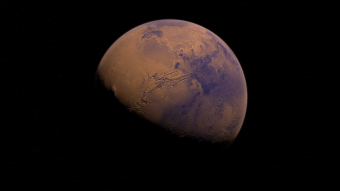I wouldn’t trade my planet for any extraterrestrial habitat. Still, for some powerful individuals, it seems that even the most beautiful places on Earth are no longer exciting enough – so their gaze (and budget) increasingly turns toward Mars. Why humanity is so determined to colonize the red planet remains an open question. What is certain, however, is that it won’t happen any time soon – the technology we currently possess is still not up to the task of surviving in such extreme conditions.
One of the key questions when thinking about long-term human presence beyond Earth is how we will ensure sustainable living conditions. For instance, transporting construction materials from Earth is logistically complex and economically unsustainable – and the same goes for resources needed to grow plants, microorganisms, and other life forms that make up the basis of any ecosystem.
How do we create a closed system that not only protects humans from extreme conditions but also allows for the cultivation of organisms we depend on – from food to oxygen? This question is increasingly shifting the focus from traditional engineering solutions to approaches inspired by biology.
That’s why a recent study by scientists at Harvard’s School of Engineering and Applied Sciences caught my attention – not only for its innovative use of bioplastics and algae in extreme conditions, but also for the shift in perspective it represents: instead of bringing everything we need with us, can we grow some of the necessary resources on-site, in conditions similar to those on Mars?
The experiment, led by Professor Robin Wordsworth’s team, successfully grew algae under Mars-like conditions using bioplastic as the foundation for a closed habitat. Specifically, they used Dunaliella tertiolecta, known for its resilience and ability to perform photosynthesis under harsh conditions. The algae grew inside a chamber made of polylactic acid, a bioplastic that allows light to pass through while blocking harmful UV radiation.

The significance of this experiment is multifaceted. First, it demonstrates that it’s possible to create a controlled environment suitable for photosynthetic organisms even at a pressure of only 600 pascals – equivalent to the atmosphere on Mars. Second, the chamber successfully stabilized liquid water, a major challenge in low-pressure conditions. Third, and most importantly, the idea that bioplastics can be produced locally using algae opens up the possibility of a closed-loop system – where the habitat and the organisms within it support each other’s survival.
In this context, bioplastics are not just substitutes for industrial materials but a potential foundation for sustainable infrastructure beyond Earth. The concept departs from the traditional engineering approach based on transporting and storing materials: here, we’re talking about a system that grows and regenerates locally through biological processes.
Interestingly, researchers didn’t stop with Mars. The next step is to test these systems in a vacuum, which would make them applicable on the Moon and in deep space. In parallel, they are developing a functional closed-loop system that could integrate production, growth, protection, and adaptation into a single efficient whole.
It’s important to note that such technologies are not being developed solely for future space colonization. Many of the principles behind them – circular systems, local production, reduced dependence on external resources – are directly applicable to sustainability efforts on Earth.
These studies don’t offer final solutions, but they do represent tangible steps toward self-sustaining systems. In that sense, bioplastic habitats with algae may not be the first homes on Mars – but they could form a vital foundation for rethinking how we build and sustain life anywhere in the Solar System.
